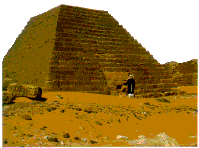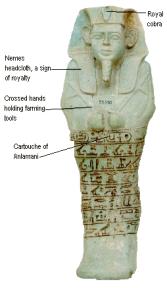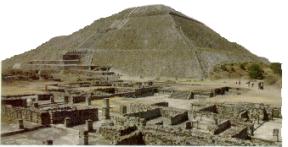|
|

|
To
the south of Egypt further up the River Nile lies Nubia, known to the
ancient Egyptians as "Kush". This desert land was one of the
cradles of African civilization, and was rich in gold and exotic goods.
Nubia’s position on the Nile gave it great strategic importance, and for
centuries Egypt’s pharaohs fought to control it. There are more than a
hundred pyramids in Nubia. They were all plundered for their stone over
the centuries, and today most of them are shapeless mounds. The first
Nubian pyramids were built around 700 B.C., during a brief period when the
Nubian kings ruled Egypt. They are at Kurru and Nuri, near Napata, the
Nubian capital. When the capital was moved south to Meroe, around 300
B.C., pyramids were also built there. The kings and queens were mummified
and buried underneath. |
 For
about a hundred years, the kings of Nubia were also pharaohs of Egypt. The
Nubians were fascinated by the culture and religion of Egypt, and even restored
temples there. The mummy-shaped statue was thought to have magical power to work
for the dead person in the next world. The Egyptians were buried with 401 shabti
figures – one for each day of the year, plus 36 bosses carrying whips. But one
Nubian king had 1,277, more than three times the usual number. For
about a hundred years, the kings of Nubia were also pharaohs of Egypt. The
Nubians were fascinated by the culture and religion of Egypt, and even restored
temples there. The mummy-shaped statue was thought to have magical power to work
for the dead person in the next world. The Egyptians were buried with 401 shabti
figures – one for each day of the year, plus 36 bosses carrying whips. But one
Nubian king had 1,277, more than three times the usual number.

|
King
Anlamani ruled before his brother, Aspelta. This shabti figure of the king
is one of 282 found in his pyramid at Nuri. They were all carved by hand,
not made in a mould. The king has a massive, chunky body, with a small
head and a huge numes head cloth. |
|
